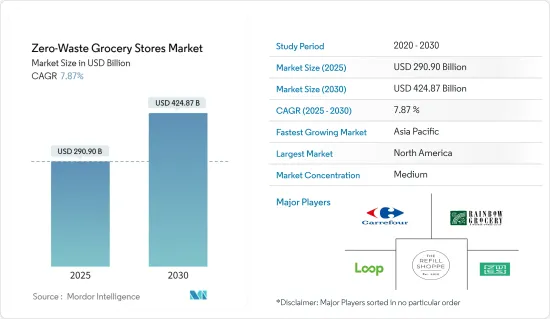
제로웨이스트 식료품점 시장 규모는 2025년 2,909억 달러, 2030년 4,248억 7,000만 달러에 달할 것으로 예측되며, 예측 기간 중(2025-2030년) CAGR은 7.87%로 예상됩니다.

제로웨이스트 매장은 소매 상황을 재구성하고 플라스틱이나 포장을 사용하지 않는 쇼핑 경험을 고객에게 제공합니다. 이러한 점포는 주로 리필용이나 벌크 푸드 옵션에 중점을 두고, 쇼핑객에게 식품, 퍼스널케어, 클리닝 제품용의 용기를 지참하도록 촉구하고 있습니다. 이러한 점포의 수는 세계적으로 증가하고 있으며, 온라인 플랫폼에서 클라우드 펀딩을 모집하는 점포도 많습니다. 포장재를 사용하지 않을 뿐만 아니라, 폐기물 제로의 점포는 홀리스틱하고 지속 가능한 이념을 내걸고, 현지산이나 유기농의 상품을 폭넓게 소개합니다. 이 독특한 접근 방식은 전통적인 소매점과는 구별되는 점이며 틈새 시장을 개척합니다.
지속 가능한 쇼핑 운동의 최전선에 서 있는 제로웨이스트 식료품점은 컨셉뿐만 아니라 실천에 있어서도 성명을 내고 있습니다. 그 영향은 폐기물 감소에 대한 노력뿐만 아니라 주요 식료품 소매 체인의 반응을 자극하고 있기 때문에 분명합니다. 미국 슈퍼마켓은 식품 판매점의 불과 10%를 차지할 뿐임에도 불구하고 연간 식품 폐기량에 수십억 달러의 거액을 더했습니다. 또한 식품 포장만으로 매립 폐기물 전체의 23%를 차지합니다.
다양한 상품을 제공하는 것으로 알려진 슈퍼마켓이나 하이퍼마켓에서는 유통 채널에 제로웨이스트 식료품점을 포함하는 움직임이 급증하고 있습니다. 이 매장은 랩, 가방, 빨대와 같은 기존 포장을 대체하는 것을 제공하여 일회용 플라스틱 사용을 방지하는 기회를 제공합니다. 그럼에도 불구하고, 전통적인 슈퍼마켓/하이퍼마켓은 특히 신선식품에서 여전히 인기있는 쇼핑 장소입니다. 특히 일회용 플라스틱 포장에서 벗어난 슈퍼마켓에서는 야채 매출이 현저하게 급증했습니다. 환경 면에서의 이점뿐만 아니라 폐기물을 0으로 만드는 것은 인건비, 에너지, 폐기 비용을 줄이고 기업에게 상당한 비용 절감을 초래합니다.
온라인 소매 채널은 예측 기간 동안 가장 빠르게 성장할 것으로 예상됩니다. 이 기세는 세계 온라인 쇼핑 증가로 인해 소비자 행동의 명확한 변화를 보여줍니다.
환경 의식이 높아짐에 따라 플라스틱 폐기물의 영향에 대한 감시의 눈도 엄격해지고 있습니다. 미국과 캐나다의 개인은 지속가능성을 향한 운동의 선두에 서 있습니다. 이러한 변화를 뒷받침하기 위해 이 지역 정부는 환경 폐기물을 관리하는 이니셔티브를 개발하고 있으며 향후 몇 년동안 시장이 크게 성장할 무대를 마련하고 있습니다. 점포가 적극적으로 폐기물을 삭감하고 있는 것은 분명하지만, 대기업 소매 슈퍼마켓 체인도 이 동향을 도입하고 있습니다.
슈퍼마켓만으로도 미국에서 연간 배출되는 식품 폐기물의 10%를 차지합니다. 또한 식품 포장은 매립 쓰레기의 23%를 차지합니다. Kea Food, Kroger, Walmart 등 대기업이 주도하는 '10x20X30 이니셔티브'를 통해 향후 10년간 식품 폐기물을 줄이는 것을 목표로 하고 있습니다. 2030년까지 이러한 주요 소매업체는 각각 20개 이상공급업체와 협력하여 폐기물 감소 노력을 더욱 추진하고자 합니다. 지속 가능한 쇼핑의 추진이 확대되어, 제로웨이스트 점포가 새로운 상식이 될 것입니다.
제로웨이스트 식료품점 시장은 반 고착된 상황을 보여주고 있으며 현재 선택할 수 있는 옵션은 많지 않습니다. 이 보고서는 Rainbow Grocery, Loop, Zero Waste Eco Store, Carrefour, and The Refill Shoppe과 같은 주요 기업을 다루고 경쟁의 역학을 조사했습니다.
The Zero-Waste Grocery Stores Market size is estimated at USD 290.90 billion in 2025, and is expected to reach USD 424.87 billion by 2030, at a CAGR of 7.87% during the forecast period (2025-2030).

Zero waste stores are reshaping the retail landscape, offering customers a plastic and packaging-free shopping experience. These stores primarily focus on refill and bulk options, encouraging shoppers to bring their containers for food, personal care, and cleaning products. The global count of such stores has surpassed, with many new ones seeking crowdfunding on online platforms. Beyond being packaging-free, zero-waste stores often champion a holistic, sustainable ethos, showcasing a range of local and organic products. This distinctive approach sets them apart from traditional retailers, carving a niche for themselves.
Zero-waste grocery stores, at the forefront of the sustainable shopping movement, are making a statement not just in concept but also in practice. Their impact is evident, not only in their waste reduction efforts but also in catalyzing responses from major retail grocery chains. Despite accounting for just 10% of food outlets, US supermarkets add massive billions of dollars to the total yearly food waste. Furthermore, food packaging alone constitutes 23% of all landfill waste.
Supermarkets and hypermarkets, known for their diverse product offerings, have seen a surge in the inclusion of zero-waste grocery stores within their distribution channels. These stores present a unique opportunity to combat single-use plastic by offering alternatives to traditional packaging, such as plastic wraps, bags, and straws. Despite this, traditional supermarkets and hypermarkets remain popular shopping destinations, especially for fresh produce. Notably, supermarkets that transitioned away from single-use plastic packaging witnessed a remarkable surge in vegetable sales. Beyond the environmental benefits, going zero-waste also translates to significant cost savings for businesses, cutting down on labor, energy, and disposal expenses.
The online retail channel is poised for the swiftest growth during the forecast period. This momentum is fueled by the global uptick in online shopping, indicating a clear shift in consumer behavior.
As environmental consciousness rises, so does the scrutiny of the repercussions of plastic waste. Individuals in the United States and Canada are spearheading the movement toward sustainability. Bolstering this shift, governments in the region have rolled out initiatives to manage environmental waste, setting the stage for significant market growth in the coming years. While it's evident that stores are actively reducing waste in their operations, major retail supermarket chains are also embracing this trend.
Supermarkets alone contribute to 10% of food waste produced annually in the United States. Additionally, food packaging constitutes a significant 23% of landfill waste. Through the "10x20X30 Initiative," spearheaded by major players like Kea Food, Kroger, and Walmart, the goal is to slash food waste over the next decade. By 2030, these leading retailers aim to collaborate with at least 20 suppliers each, furthering their waste reduction efforts. As the push for sustainable shopping gains momentum, zero-waste stores are set to become the new norm.
The zero-waste grocery store market exhibits a semi-consolidated landscape, with only a handful of options available presently. The report delves into the competitive dynamics, highlighting key players such as Rainbow Grocery, Loop, Zero Waste Eco Store, Carrefour, and The Refill Shoppe.